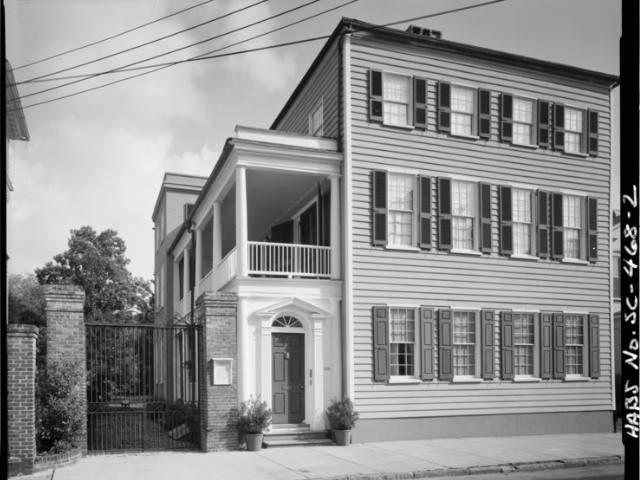
Dr. Peter Fayssoux House, 126 Tradd Street, Charleston, Charleston County, SC. Library of Congress Prints and Photographs Division.
(1745-1795) Fayssoux was born in Charleston, S. C., the son of Daniel Fayssoux and his wife Frances. In 1766 Fayssoux went to medical school in Edinburgh. Returning to South Carolina in 1769, he found the city full of quacks and quoted to a friend: “It is Sufficient for a man to call himself a Doctor, & he immediately becomes one, & finds fools to employ him.” On January 29, 1772, Fayssoux married Sarah “Sally” Wilson, who died in 1776. The following year, on March 29, 1777, Fayssoux married Ann Smith Johnston. The marriages produced thirteen children, six of whom died in infancy or early childhood.
Early in the Revolutionary War, Fayssoux attended the sick on James Island and provided advice on extracting salt from seawater. By 1778 he was serving as “senior physician” of the South Carolina branch of the Continental army. Fayssoux was with General William Moultrie at the Battle of Sullivan’s Island on June 28, 1776. In 1779, when Moultrie repulsed a British force threatening Beaufort, Fayssoux was given the task of remaining with the sick until Moultrie could supply the necessary carriages to remove them. Captured at the fall of Charleston, he was released in order to attend to the sick and wounded in the city. After the Battle of Eutaw Springs on September 8, 1781, the responsibility for the wounded fell to Fayssoux. At the end of the war Fayssoux was treating the sick and wounded in Camden, where he stayed until March 1782.
After the war Fayssoux became a member of the Faculty of Physic in Charleston, which was the first evidence of organized medicine in South Carolina. Along with Alexander Baron and David Ramsay, Fayssoux comprised the organizing committee charged with reporting a plan to improve “the Science of Medicine…amongst the Practitioners in this City.” He was a founding member and the first president of the Medical Society of South Carolina, which held its first meeting at Fayssoux’s home on December 24, 1789. Though he made no literary contributions to medicine, his leadership in the early organization of medicine and his contributions to the Revolution placed him among the major medical figures of his time.
In 1786 Fayssoux was elected to the General Assembly, where he represented St. John’s Berkeley Parish until 1790. He voted against ratification of the federal Constitution in 1788 but afterward accepted the new government amicably. In addition to his medical and political activities, Fayssoux was involved with the Charleston Library Society, the Charleston Museum (as a curator), the Society of the Cincinnati (founding member), and the St. Cecilia Society. He died on February 1, 1795, of apoplectic stroke and was buried in the churchyard of First (Scots) Presbyterian Church, Charleston.


